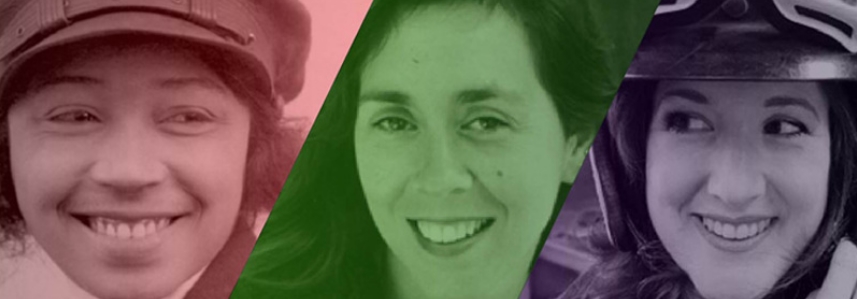
Take a minute and picture a motorcyclist.
Maybe you conjured a long-haired outlaw like Jax Teller from Sons of Anarchy. Perhaps you visualized Ewan McGregor and his motorcycle adventures abroad. Or possibly you thought of the last motorcyclist who shot past you on the Interstate.
But chances are that you thought of a man—not a woman.
There are 8.4 million motorcycles registered in the United States—a tiny number compared to the 264 million registered cars and trucks. Motorcyclists are definitely a subculture and a heavily male-dominated one at that. Only 14%–about 1.18 million—of the motorcycles on American roads are registered to women. The American Motorcyclist Association encourages more women to try motorcycling if they are interested. As the AMA’s Managing Editor Jim Witters notes, “there’s always room for more riders.”
Women riders should be as common as women drivers.”
–Maggie McNally, Chair of the American Motorcyclist Association. McNally is the first female chair of the AMA in its 94-year history.
But numbers aside, women motorcyclists simply haven’t broken through in the American popular imagination. That doesn’t mean there are no motorcycle heroines. In fact, there are many female motorcyclists who deserve broader public attention for their taboo-smashing derring-do and their insight into the souls of two-wheeled conveyances and the people who ride them. Three of them are particularly worthy of celebration: Lois Pryce, Melissa Holbrook Pierson, and Bessie Stringfield, three riders who took very different journeys on what Pierson calls “the perfect vehicle.”
One woman rode outward across whole continents and forged personal connections in remote and forbidden countries. Her vulnerability and good humor were her strengths.
Another rode inward through her own psyche to understand the allure of motorcycles and the people who ride them. Her fearless and honest introspection were her guides.
Their spiritual ancestor rode onward to confront the institutionalized racism and sexism of Jim Crow America. Her powerful faith and personal toughness were her allies.
Let’s meet them.
The Journey Outward: Lois Pryce
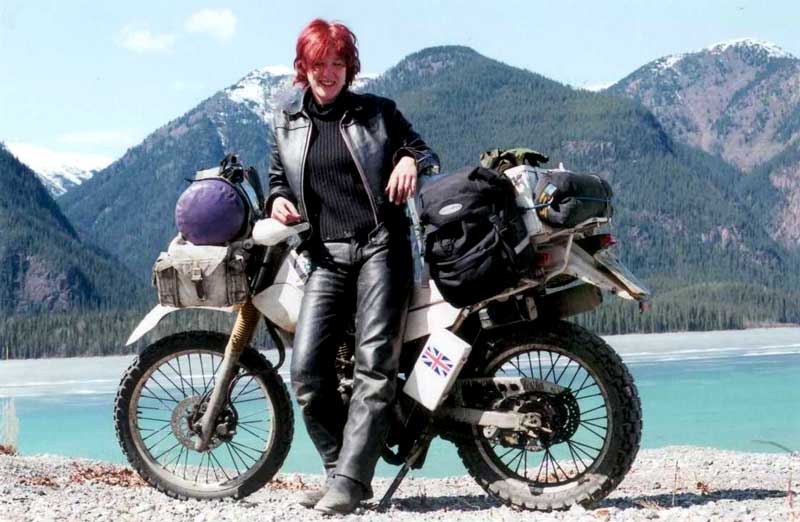
Lois Pryce rode all the way down to the southern tip of South America, from Alaska to Tierra del Fuego, where you can smell Antarctica 620 miles away across the Drake Passage.
She rode all the way from London to Cape Town, traversing the Sahara Desert, the jungled interior of sub-Saharan Africa, and the sun-blasted hills of South Africa.
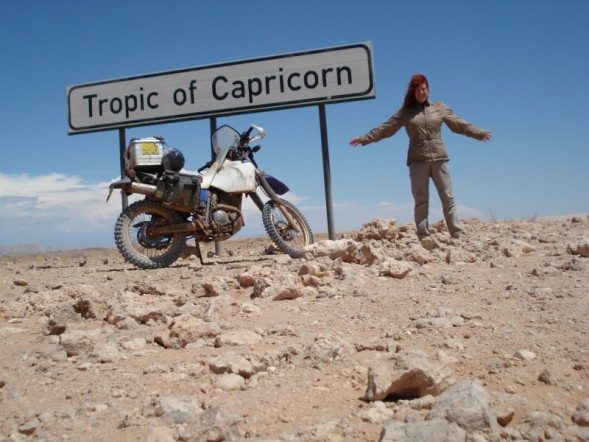
She rode across Turkey and crossed into Iran, a country that we in the US and the UK have been locked in a cold war with for 40 years. It was her most intimate trip, a journey around the country that brought her into close contact with dozens of ordinary Iranians who showered her with kindness.

Pryce did what so many only dream of. She left a desk job with the BBC and set out to explore the world by motorcycle. She’s taken three epic motorcycle trips: from Alaska to the southern tip of South America, from London to Cape Town, South Africa, and from Istanbul to Iran. Along the way, she witnessed the aftermath of a horrific motorcycle crash that left one of her riding buddies with a fractured skull and a mangled arm. She clashed with officious policemen and border control officers who seemed determined to thwart her desire to see what lay beyond the next hill. She endured the heat of the Sahara Desert and the bone-chilling cold of the Zagros Mountains in northwestern Iran.
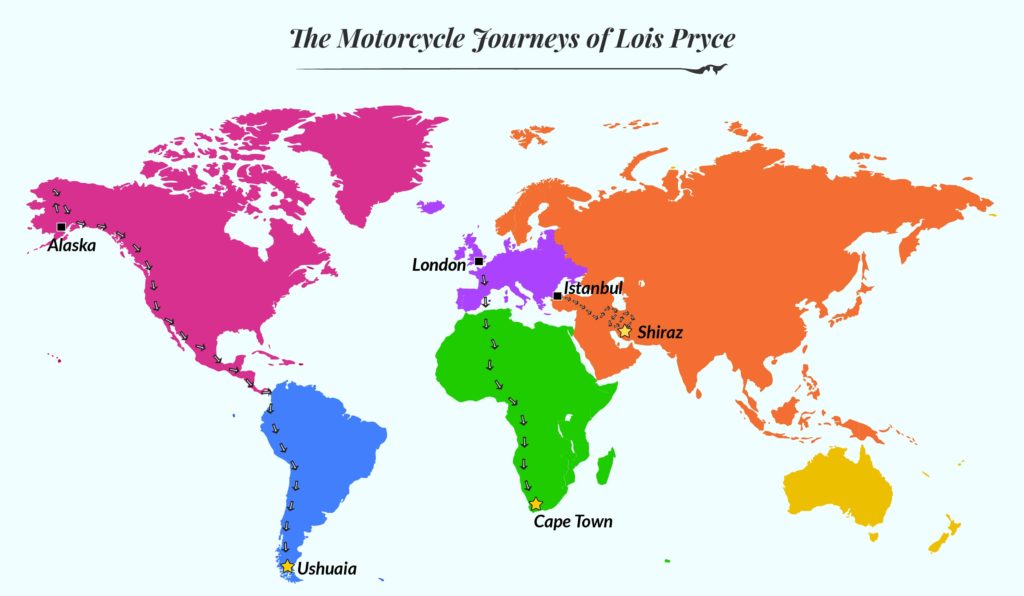
Never one to follow the motorcycling in-crowd, Pryce rides smaller bikes—225 and 250 cc Yamahas that are light, easy to work on, and far more in keeping with the motorcycles in the places she travels than big BMWs, Harleys, or Ducatis.
As she said in an interview for this article,
as soon as you leave the Western/developed world there’s not much opportunity to ride at 70-plus miles per hour. The kinds of roads you’ll be traveling on are full of potholes, dirt, kids, dogs, donkeys, cows, insane traffic etc. This means you will be riding much slower than that most of the time – so a big powerful bike is wasted. Also, riding slowly means you see more. A small bike forces you to carry less stuff, which is good – traveling light will transform a trip. Another benefit of riding a small, cheap trail bike is that you will blend in better in less-developed countries. Turning up on a big flashy brand-new BMW or similar marks you out as a wealthy westerner and creates a divide between you and the people of that country.”
Pryce also gained a unique perspective on the perception that motorcycles as dangerous machines. One of the scariest days of her life occurred in the Republic of Congo, when she was forced to take a train from Loutété to Brazzaville because the road was “too dangerous” to be traversed by a lone woman on a motorcycle. She was shut up in a boxcar with her motorcycle and a dozen intoxicated male Congolese soldiers. There was no escape. She spent a sleepless night sitting on the floor of the boxcar by her bike, fending off some soldiers who wanted to steal her supplies and other soldiers who made it clear they might want something more from her. Had she been out on the road, she could have escaped those dangers.
Motorcycling is so much more experimental than driving. Riding allows you to experience life through your five senses instead of watching it through a windshield.
Peter Ter Horst, Spokesman for The American Motorcycle Association & President of SymPoint Communications.
But despite that terrifying situation—and despite being assaulted by a meth-head gas station attendant in Iran, Pryce believes that being a woman on a motorcycle in a foreign land actually helps keep her safer than a man would be.
“Being a woman can be advantageous as on the whole,” she said. “When people see you traveling in their country, especially if you are alone, they actually want to look after you, rather than harm you. I truly do believe this is how most humans respond to others. A solo female is not viewed as a threat in any society, so people tend to be welcoming and friendly. Obviously, there is the occasional lecherous or scary guy, but you soon learn to sniff them out right away!”
This idea of strength through vulnerability was the theme of a TEDx talk Pryce gave in 2015. On to her first epic journey from Alaska to Tierra del Fuego, she learned that “the reason to travel is to make human connections. To make those connections meaningful and real, you have to lay yourself bare. You can’t insulate yourself and hide away. You have to be vulnerable…. Your vulnerability becomes an asset and brings out the best in people.”
I’ve known Lois since 2010 and consider her to be a remarkable world traveler and gifted writer. She’s one of the original group of motorcycle adventurers and also one of the first women riders to take on the world solo. Few authors in this genre can capture these life-changing experiences, inform us how things really are out there, and provide so many chuckles along the way.
-Paul Smith, Senior Editor, Adventure Motorcycle Magazine
In between epic motorcycle journeys, Pryce wrote three books: Lois on the Loose, about her trip through North and South America, Red Tape and White Knuckles: One Woman’s Adventure Through Africa, and Revolutionary Ride: On the Road in Search of the Real Iran. With her husband, Austin Vince, she co-organizes the Adventure Travel Film Festival, an event dedicated to showing 100 years of adventure travel films, listening to good music, and hearing talks from trekkers, bicyclists, overlanders, sailors—and, of course, motorcyclists.
The Journey Inward: Melissa Holbrook Pierson
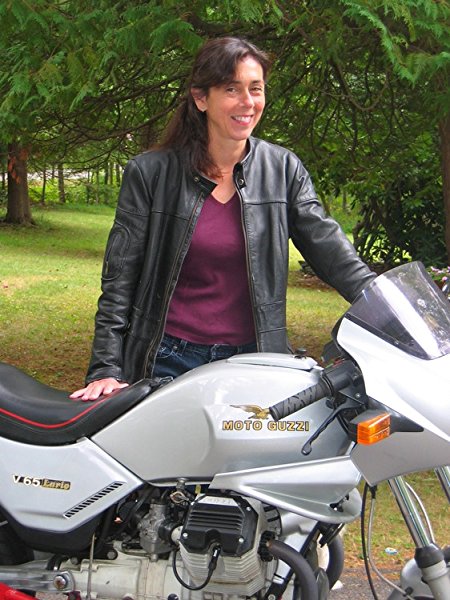
The Perfect Vehicle: What It Is About Motorcycles, by Melissa Holbrook Pierson, begins with a lyrical passage that reads like a description of a religious rite. “The key is slipped into the ignition at the top of the steering head. Then the rider swings a leg over the seat and sits but keeps the weight on the balls of the feet. With a push from the thighs, the rider rocks the bike forward once, again, picking up momentum until it starts to fall forward and down from the centerstand… The key turns; idiot lights glow.… The starter button on the right handlebar, pressed, begins a whirring below. A simultaneous twist of the right grip pulls the throttle cables and the engine bleats, then gulps, then roars. There is contained fire within inches of the rider’s knees.”
Given Pierson’s attentiveness to the rituals of the ride, it’s not surprising that many pages on, she tells of her visit to a motorcycle museum in Otterbach, Germany in spiritual terms: “We admired all the fine old bikes, from Aermacchi to Zundapp, sure, but I think we were at least as appreciative of the fact that they were housed in a former church. It was still a place of worship as far as we were concerned.”
But what begins as ritual soon becomes a psychological inquiry. To invert Pierson’s subtitle, what is it about motorcycles? It’s certainly more than just the ride. The closest she comes to giving a direct answer is to say that “motorcycles are a way into yourself, and a way out.”
By writing The Perfect Vehicle, Pierson had hoped to communicate the essence of motorcycling to a general audience. But that’s not the way it worked out. The book was popular among motorcyclists, but non-riders took little note of it.
In an interview for this article, Pierson also laments how technology has affected her connection with her motorcycles. “Now I feel a tad . . . distant from my bikes. This extends to the ride because I’m no longer able to pay the close attention I once did to the inner workings of the stationary motorcycle. Or to relate in a physical way to much of what’s happening when [I’m] underway. And that’s because I can’t—it’s all inside the invisible workings of a chip that is not ‘read’ by me, but by a computer.”
Pierson came to motorcycling in her mid-twenties, after getting her bachelor’s from Vassar and her master’s from Columbia. Once she discovered motorcycles, a different kind of learning took hold of her. She discovered the joy, power, peace, fear, vulnerability, and happiness that can visit a rider in just ten miles.
She rode around New York City and its near environs. She rode America through and through. She rode in Europe. But the real travel is through the landscape of the psyche. The Perfect Vehicle is as much of a travelogue as Zen and the Art of Motorcycle Maintenance is about the highways of the northwest. Which is to say that it isn’t really about those roadways at all.
To make these inward journeys, Pierson doesn’t ride trail bikes, crotch rockets, or plush cruisers. She favors the sculpted, sinewy, Italian designs of Moto Guzzi: “I would know the sound of a big Guzzi in my sleep. It concentrates its aural energies in your upper chest, ringing through your bones. It is…the sound of joy.”
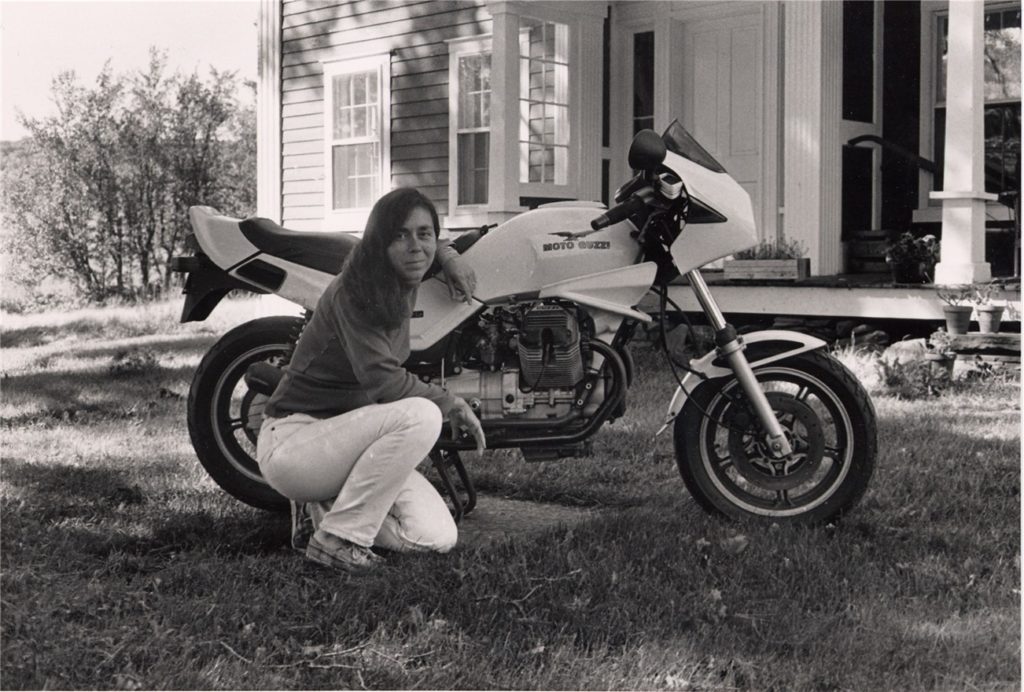
Melissa writes so that you are on that bike, the wind rushing by, and feeling every bump and bend in the road. Beyond summoning the exquisite sense of riding a motorcycle, she summons the bike’s physicality in its lines and weight, but especially in its sound.
–Amy Cherry, Vice President & Senior Editor, W. W. Norton & Company
Despite her status as a female rider, Pierson is careful not to attempt to speak for all women motorcyclists. “I don’t think riding itself is a gendered experience,” she said in an interview for this article. “It’s the way the rider is perceived that’s gendered. . . . Women have to push through an extra layer of resistance sometimes, in that we may have to first take back a basic right to do what we want to do without censure. In cultures that have strong gender prescriptions, this can be at the risk of physical punishment, but in many of the most dramatic instances where this is the case worldwide, there are now examples of women who have taken to motorcycles even under pain of physical harm, which is a new and amazing development. Men don’t face that.”
Pierson’s second motorcycle book, The Man Who Would Stop at Nothing: Long-Distance Motorcycling’s Endless Road, was published in 2011. She hadn’t planned to write about motorcycling again until she encountered the extreme long-distance motorcycle subculture, people who ride 1,000 miles in a single day in “iron butt” marathons. “It’s such a loony, all-absorbing pursuit, I knew I’d have to write about it,” Pierson remarked. “I still think those people are nuts. But they’re among the smartest, most generous humans I’ve ever encountered. There’s got to be a connection there.”
More recently, Pierson took a trip through India, another one of those journeys that broadens the mind, the soul, and the horizon.
And she’s still discovering what it is about motorcycles.
The Journey Onward: Bessie Stringfield
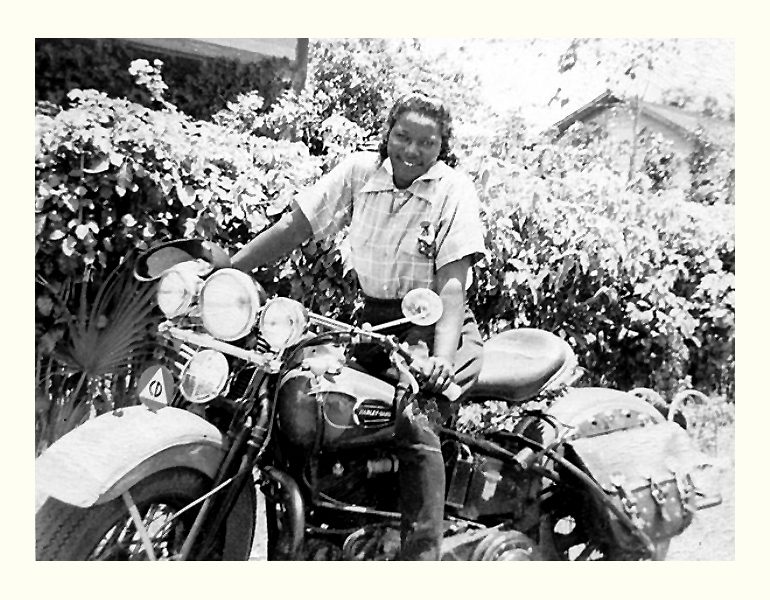
Bessie Stringfield measured only 5’2”, but she stood tall at a time when to be black and female was to be doubly oppressed. Photos of her show a sturdy woman with an inviting smile. She always appears freshly made up and impeccably dressed, even when photographed against a backdrop of dusty roads and dirt tracks. Born in 1911, she taught herself to ride in the 1920s on a neighbor’s bike when she was in her mid-teens and the modern motorcycle itself was only about ten. “My mama had a fit,” she later recalled. “Nice girls didn’t go around riding motorcycles in those days.”
Nevertheless, on her sixteenth birthday, Stringfield’s adoptive mother gifted her with what she really wanted: a ride of her own. It was a 1928 Indian Scout, an American contraption that looked like a bicycle on steroids with a 603 cc V-twin engine nestled between the wheels. It was heavy and loud and belched exhaust, but it must have seemed like freedom. It was her first and last Indian. Thereafter, Stringfield discovered Harley-Davidsons and immediately developed the kind of brand loyalty that marque inspires. She owned 27 different Harleys in her lifetime.
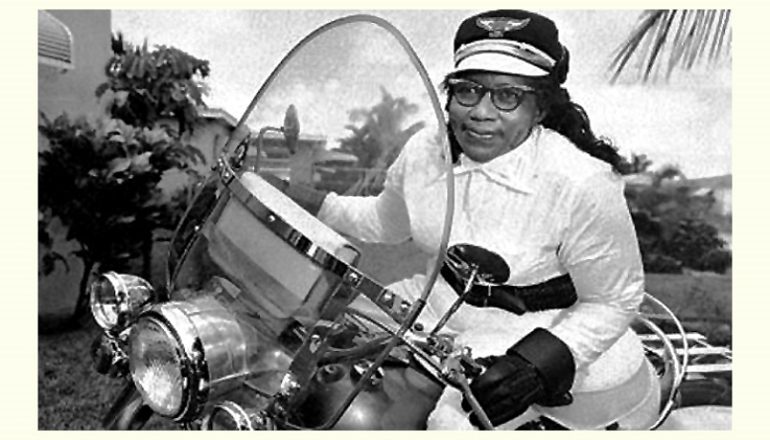
By the time she was 19, Stringfield was riding all over the country.
Some say she would choose her destinations by tossing a penny onto a
map. It’s hard for those of us who were raised alongside the Interstate
Highway System to imagine how difficult motorcycle travel was in 1930.
Roads in the United States at that time were topped with graded earth,
sand, clay, or gravel—surfaces not especially hospitable to motorcycle
traffic. Even the basics of navigating from town to town were difficult
in an era where interstate roadmaps were still in their infancy.
The risks of motorcycling and the sheer difficulty of long-distance travel in that era would daunt all but the hardiest souls. Stringfield, however, encountered additional obstacles: her black skin and her woman’s body. It was perfectly legal in the 1930s for hotels, restaurants, and inns to refuse to serve African Americans and unaccompanied women. Stringfield spent many nights staying with black families she met on her travels. Other evenings were passed parked at a filling station and sleeping atop her bike. These aspects of Jim Crow America were almost benign compared to the more serious dangers of being black and far from home in a white world. In the 1930s, 119 African Americans were lynched. Hundreds of others were beaten, tortured, raped, and humiliated. The protection of the law was uncertain and inconstant, to say the least.
Bessie Stringfield was a black woman in a white man’s world and a woman in a male-dominated culture. She helped pave the way for the civil rights era. She’s definitely a hero!
-Maggie McNally, Chair of The American Motorcyclist Association
But Stringfield was undeterred. She became the first African American woman to ride a motorcycle in every one of the contiguous 48 states. She rode in Brazil, Haiti, and Europe. She raced in flat track competitions and performed motorcycle stunts at carnivals and fairs. During World War II, she served as a civilian motorcycle courier for the US Army in the pre-fax, pre-internet era, carrying important military documents from base to base.
In later years, Stringfield was remarkably reticent about the discrimination she faced on the back roads of midcentury America. In a newspaper interview of in 1981, she recalled that “colored people couldn’t stop at hotels or motels back then. But it never bothered me.”
When pressed by reporters and biographers, she would relate an incident where a white man in a pickup truck deliberately ran her off the road and knocked her off her bike. She told other stories about being followed down a dirt road by an angry white mob only to outrun them and fill her tank at a gas station owned by a kindly white man who let her fill up for free. But even those tellings are devoid of anger or bitterness.
Perhaps she guarded her carefully-wrought image as a positive, can-do spirit. Perhaps her powerful Catholic faith impelled her to turn the other cheek. She frequently said that “the man upstairs” was looking out for her. Or maybe she was actually lucky and plucky enough to have avoided the worst of Jim Crow violence and hatred.
But one oft-told anecdote hints at the quiet pride she took in her skill and determination. When she moved to Florida in the 1950s, she found herself repeatedly pulled over by the police for “riding while black.” As Stringfield tells the story, the Miami police told here that black women were not allowed to ride motorcycles in Miami.
“I couldn’t even get a motorcycle license there. Those officers kept harassing me until I got fed up and went to see Captain Jackson, a white motorcycle cop in the Negro district. He took me out to a park and told me to go through several figure eights and other tricks. I did them, and he was amazed. He said he’d never seen a woman ride like that. From that day on, I didn’t have any trouble from the police and I got my license too.”
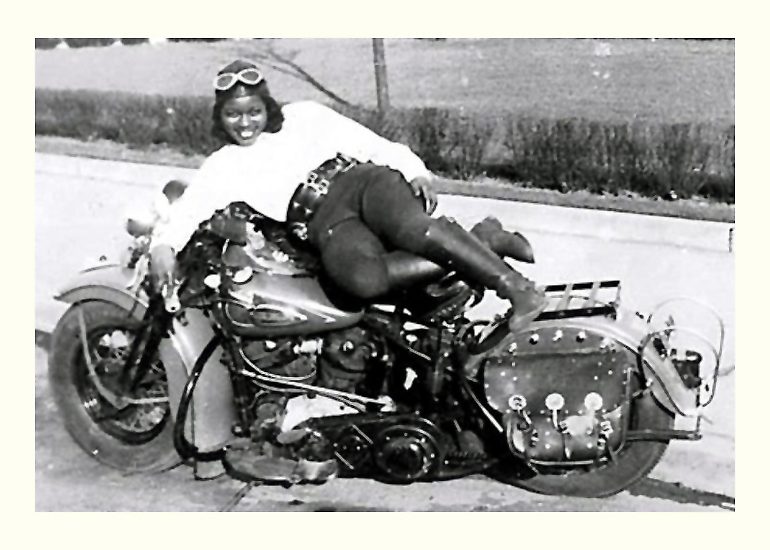
Stringfield died in 1992 at the age of 82. She rode her
Harley to church every Sunday until shortly before her death.
Recognizing that it had neglected to write about her death when it
occurred, The New York Times belatedly published an obituary in 2018. In
2000, the American Motorcyclist Association Hall of Fame created the Bessie Stringfield Award
to honor “an individual who has been instrumental in bringing emerging
markets into the world of motorcycling.” Two years later, the AMA inducted her into its Hall of Fame.
And today, there are legions of women who ride in her honor.
Three Women, Three Journeys
Most of us who ride will never even attempt the outrageous distances that Lois Pryce covered. We’ll never have the insight to report on the combination of insecurities, contradictions, and fearless self-analysis that allowed Melissa Holbrook Pierson to dive deep into “what it is about motorcycles.” And we’ll never (we hope) have to transcend the racism and sexism of the day and smash through the cultural stereotypes that Bessie Stringfield had to contend with for much of her riding life. Riding outward, inward, and onward, these three women have mapped out trails for the rest of us.
Now it’s up to us to act on their inspiration.
Jim Trumm
This article was first published on www.ConsumersAdvocate.org, after request we reposted the article here. Thank you for these inspiring stories!